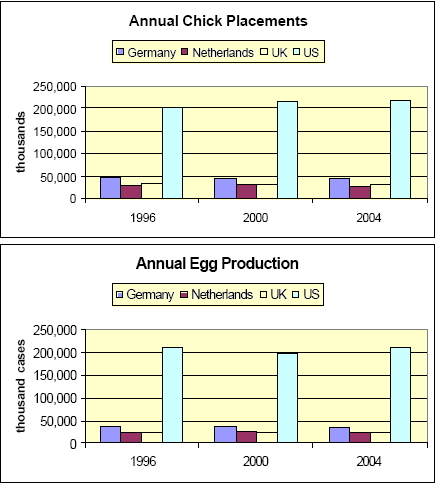



International Egg and Poultry Review: Germany
By the USDA's Agricultural Marketing Service - This is a weekly report looking at international developments concerning the poultry industry, this week looking at the Comparison of Egg Production in Germany, the Netherlands, the United Kingdom and the United States.
Comparison of Egg Production in Germany, the Netherlands, the United Kingdom and the United States
Annual chick placements have been declining in Germany, from 46.1
million in 1996 to 45.7 million in 2000 and 44.0 million in 2004. Egg
production totaled 38.7 million cases (30 dozen cases) in 1996,
dropping to 38.5 in 2000 and 34.4 in 2004.
In the Netherlands, placements totaled 28.8 million chicks in 1996,
32.7 million chicks in 2000, 26.3 million chicks in 2004. Egg production
was 25.1 million cases in 1996, 27.8 million cases in 2004 and 25.6
million in 2004. An outbreak on highly pathogenic avian influenza (H7N7)
in 2003 led to the loss of 55 percent of the table egg production in the
Netherlands. Germany and Belgium had limited loss to the avian
influenza outbreak.
The UK’s chick placements were 33.4 million in 1996, 32.5 million in
2000 and 32.7 million in 2004. Egg production totaled 24.6 million
cases in 1996, 23.9 million in 2000 and 26.4 million in 2004.
Chick placements in the U.S. grew steadily from 203.6 million chicks in
1996 to 214.7 million in 2000 and 218.7 million in 2004. Egg production
totaled 212.0 million cases in 1996 but dropped to 198.3 in 2000 before
rebounding to 211.8 in 2004.

Up until 2003, EU Law required a minimum space requirement of 450
square cm/bird. From 2003 to 2012 the space requirement for
conventional (not enriched) cages was increased to 550 sq cm/bird.
Effective January 1, 2002, enriched cages, which, require perches,
nest boxes and litter, were required to have at least 750 sq cm of cage
space per hen. Rearing layers in conventional cages will be prohibited
effective January 1, 2012. New conventional cages have not been
allowed to be built, or brought into service for the first time, since January
1, 2003.
Germany has prohibited housing hens in conventional cages as from
December 2006 and enriched cages will not be allowed after December
31, 2011. Between 1995 and 2004, egg production shifted from 93.7%
in cages to 77.5% in cages. The balance of birds were raised in deep
litter or free range.
In 2005, of the 30 million laying hens housed in the Netherlands, about
50 % are kept in conventional cage systems while the other half are
kept in aviaries/barns, on free range, or as organic.
The UK has a code of recommendations for laying hens. Statutory
Instrument 2000 No. 1870 set minimum cage areas at 450 sq cm
where four or more hens are kept in the cage. Statutory Instrument
2002 No. 1646 set requirements of at least 550 sq cm per hen of cage
area for all conventional cage systems. In 2004, 66% of production
was in cages, 24% free range, 7 % barn and 3% organic.
In the International Egg Commission’s Recommended Standards for
the Welfare of Laying Hens, usable space per hen in a minimum of
432 sq cm (67 sq in) for small framed birds (such as white leghorns)
and 490 sq cm (76 sq in) for large framed birds (modern brown hybrids).
In the United States, United Egg Producer Guidelines recommend 67
sq in (432 sq cm) per white egg leghorn hen and between 67 and 86 sq
in (432 - 555 sq cm) per brown egg layer hen.
Source: International Egg Commission, British Egg Industry Council,
UK Department for Environment, Food and Rural Affairs, European
Commission, new wires
To view the full report, including tables please click here
Source: USDA's Agricultural Marketing Service - 1st November 2005








